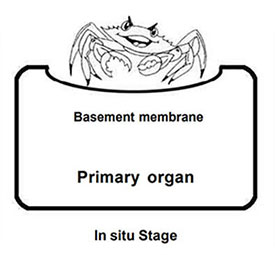Code 0: In Situ
- Translates as “in place”
- Can only be made microscopically (histologically confirmed)
- Presence of malignant cells within cell group from which they arose
- Fulfills pathological criteria for malignancy
- No invasion of basement membrane
- No invasion of supporting structures of the organ on which it arose
Pathologists have many ways of describing in situ cancer
- Intracystic
- Intraepithelial
- No penetration of/or below the basement membrane
- No stromal invasion
- Non-infiltrating
- Noninvasive
- Pre-invasive
Organs and tissues that have no epithelial layer cannot be staged as in situ, since they do not have a basement membrane (e.g., sarcomas). The SS2018 manual lists the Chapters that cannot have in situ (see page 10).

Figure 1. In situ tumor.
Source: Adapted from an illustration by Brian Shellito of Scientific American, as printed in Cancer in Michigan, The Detroit News, Nov. 1-2, 1998.

Figure 2. In situ stage.
Source: Young JL Jr, Roffers SD, Ries LAG, Fritz AG, Hurlbut AA (eds). SEER Summary Staging Manual - 2000: Codes and Coding Instructions, National Cancer Institute,
NIH Pub. No. 01-4969, Bethesda, MD, 2001.
Updated: November 5, 2024
Suggested Citation
SEER Training Modules: Code 0: In Situ. U.S. National Institutes of Health, National Cancer Institute. Cited 05 January 2026. Available from: https://training.seer.cancer.gov.




